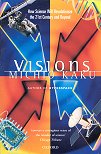There's an excellent book in here trying to get out.
The four fundamental forces of nature -- gravity, electromagnetism, the weak and the strong nuclear forces -- all have their own separate successful theories; scientists have been struggling for years to 'unify' them into one grand Theory of Everything. Anyone trying to keep track of progress has probably been confused by all the talk of gravitons, GUTs, Kaluza-Klein, Standard Models, supersymmetry, superstrings, and lots and lots of dimensions -- I know I have. Kaku here gives an historical account of progress, and manages to make everything slot into place and make some kind of sense.
Throughout the book, Kaku shows how the laws of nature are simplified by being cast in higher dimensions, and can be unified where there is enough 'room' for them all. (I remember the thrill I had the first time I ever saw Maxwell's equations written with only a few symbols using a 4-dimensional tensor, rather than their usual, more complicated form, and then later seeing gravity and EM unified in 5-dimensions.) He describes how the same ideas can be used to unify all the forces, in 10 dimensions.
My main criticism of the book is too much time spent drawing contrasts with mysticism, religion, science fiction and dialectics, which doesn't leave enough time for a deep description of the interesting stuff: the physics itself. • When we get to the ten dimensional Kaluza-Klein superstring theory, there's a bit of description of how the equations give consistent results only in 10-D and 26-D space, and how it's really a 26-D theory compacted into 10-D. Since this is the punchline somehow of the entire theory, I would have expected quite a bit of description. But it is glossed over very quickly, and I never managed to work out how this 'compaction' from 26-D to 10-D was related to the 'curling up' of a further 6 dimensions to leave us with the four space-time dimensions we know and love. • In the part about the Big Bang, I wanted to know more about the connection between those 6 dimensions collapsing, and the event itself. Does this mean this theory says there is a time before the Big Bang (contrasting with the ideas in Stephen Hawking's A Brief History of Time, which seems to say that time itself only started at the Big Bang)? Is it connected with the inflationary period soon after? • Are all the other dimensions space-like? Is there only one time-like dimension, or could some of the curled up ones be time-like too? • And so on...
But, even wanting to know more, I learned interesting things from this treatment. I can see what all those unification attempts have in common. I now have a much better understanding of what that 'curling up' means physically. (I'd previously had a confused mental picture of the dimensions coiled up like springs somehow; Kaku describes them much more comprehensibly as shrunken into tiny closed loops.) And I like the way he keeps linking the mathematics to the physical principles: I have a better physical understanding of why group theory is used to describe families of elementary particles, for example.
I have to say I'm not sure how accessible all this esoteric physics will be to the truly lay reader (I have a degree in physics -- even if I did get that degree in the late 1970s, before much of this work had filtered into the curriculum, or even been done -- so I already know some of the background.) However, anyone who has heard of some of these ideas before should come away with a better feel for how they all fit together.
A time and space for us
A manifold of dimension ten
With all but four curled up.
-- 1997

